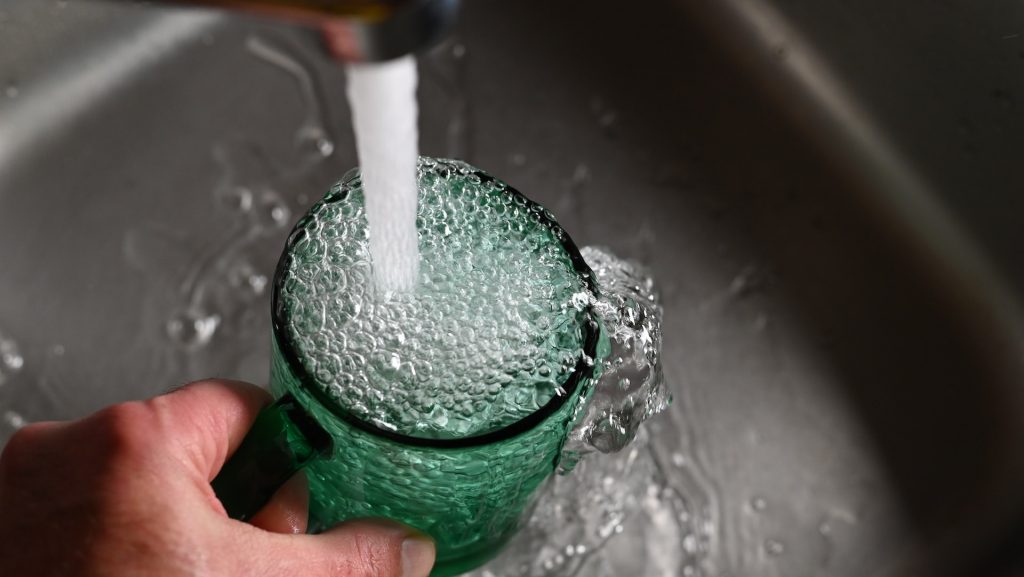Also known as materials, matter, constituents, chemicals, compounds.
Source water is water that is in its natural state, such as water in a mountain stream. Natural source water has a variety of naturally occurring substances, including metals, minerals, nutrients, organic matter and microorganisms. Sulfur and iron, for example, are naturally occurring in source water. They also give water a distinct colour and smell!
In Alberta’s Bow River and its tributaries, naturally occurring substances include fluoride, iron, calcium, magnesium and sulphate [2]. Also, in addition to material from rocks, Bow River water can contain naturally occurring constituents like parasites, bacteria, and viruses from animals upstream. See Microorganisms for more information.
Surface water in other parts of Canada will have different source water characteristics that will reflect local geography and groundwater features. For example, lakes and river in the Canadian Shield which covers a large region in Canada will have different chemical components than will be found across the Canadian Prairies.
Naturally occurring substances in water that are less common include hydrocarbons and radioactive elements. Some places in Alberta, including around the Athabasca River and Lake Athabasca, have radioactive material and crude oil in the rocks or sand, which naturally seep into water sources.

Besides the water molecules themselves (i.e., hydrogen and oxygen), there are many other things in tap water. Small amounts of naturally occurring substances are not removed by treatment processes. Tap water likely contains small amounts of minerals like calcium, fluoride and magnesium, some salts, and some dissolved organic matter.
Communities that use groundwater as a source for drinking water may find different materials in their water than communities who use river or lake water. Different minerals, metals, and substances are added depending on the type of rock or ground the water travels through.

While the natural processes that lead to substances in the water cannot be regulated, human activities that cause more natural substances to be released into water are regulated for water quality protection. Additionally, surface water quality guidelines include parameters like total dissolved solids [5], total suspended solids, various naturally occurring metals, and turbidity.
In the Bow River Basin, most naturally occurring materials are not found in high enough concentrations to negatively impact human health. However, some microorganisms are potentially harmful at any concentration. Read more about these organisms and how to avoid them on our Microorganisms Factpage.
In other regions the naturally occurring dissolved solids may limit the use of water for drinking without specialized treatment.
Water treatment plants, water filters and disinfection systems are all used to remove harmful constituents, both natural and introduced. If you have a private water supply system (like many rural area residents, on-reserve Indigenous communities, and homes not connected to public or municipal treatment systems), there may be more naturally occurring substances in your water. To determine if the water source is safe to drink it is advisable to have a sample of the water tested at an accredited testing laboratory.
Yes, but not in a negative way. Because they are natural, these substances are often consistently present in the water and therefore plants and animals have adapted to them. The natural chemistry of water is part of what makes an ecosystem unique and functional. For example, the Banff Mineral Hot Springs have high concentrations of naturally occurring materials including sulphur, calcium, and magnesium, and the plants and animals living around the springs are different compared to species in other areas of the Bow River headwaters.
Natural substances in water can be important for an ecosystem to flourish. Wetland ecosystems that receive minerals and nutrients flowing from upstream have abundant vegetation, whereas wetlands that receive only rainwater (which has almost no minerals) grow very slowly and the plant species do not need many nutrients.

As water flows over the ground and through rock, it picks up minerals, metals, bacteria, and many other materials. These substances flow in the water until they are removed by biological or physical processes. Examples include bacteria and organic matter being trapped in the sediment, and heavy metal ions being absorbed by aquatic plants.
Many substances travel through the air. These can be natural in origin (e.g. smoke from a wildfire) or human-made (e.g. exhaust from a car). Many substances in the air end up in the water system by falling with rain or snow.
In many places in Canada, you should not drink water directly from streams or rivers without suitable treatment first.
We provide Canadian educational resources on water practices to promote conservation and sustainability. Our team crafts current and relevant content, while encouraging feedback and engagement.
The Canada WaterPortal is a registered charity, #807121876RR0001
We recognize and respect the sovereignty of the Indigenous Peoples and communities on whose land our work takes place.
© 2025 All Rights Reserved.